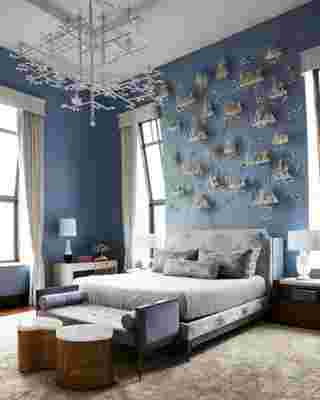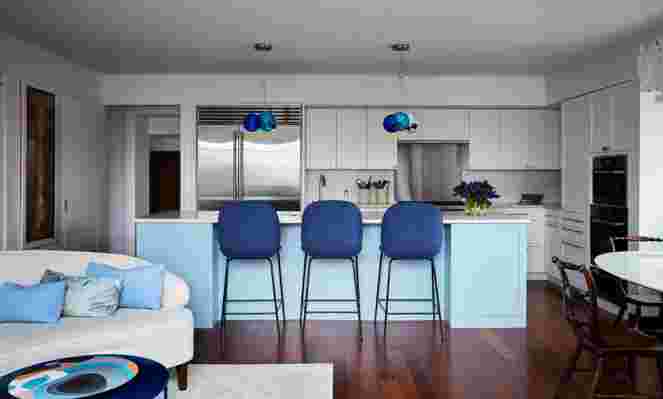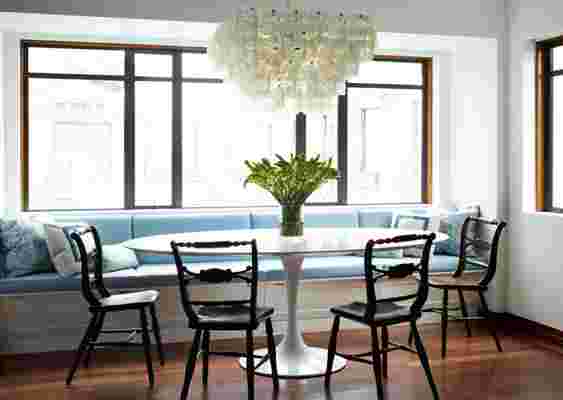Architects and designers spend a lot of energy staying true to the historical narrative of any given home, but few projects offer one as compelling as the apartment on New York City’s Upper West Side that was recently reinterpreted by interior designer Bennett Leifer and Annie Coombs of Siris/Coombs Architects. A veritable castle in the sky, the 1908 riverside penthouse once belonged to William Randolph Hearst, and its structural follies suggest the kind of eccentricities one might expect from the publishing magnate, including 30-foot-high ceilings and a hulking mansard roof above it all.
But how does one translate such grandeur and idiosyncrasy for a contemporary family? Architects Jane Siris and Peter Coombs had an idea in the 1980s, when they restored the mansard and refined the space’s proportions and spatial arrangements for an art collector and his kin. This time around, architect Annie Coombs was tasked with gently updating the renovation her parents had performed on the apartment three decades prior for new owners. Her response: to carefully peel back some of the ceilings, modernize much of the millwork, and add functional storage in places like the kitchen and master bath; she also undertook the restoration of the scene-stealing Tiffany glass panel that dominates the dining area. “It was a lot like surgery,” Coombs says of the care and precision that was employed throughout the process by her team as well as interior designer Bennett Leifer.

Covered in silk paper by Phillip Jeffries, the master bedroom functions as a stylish cocoon. Above the Hutton Collection bed, which is upholstered in Holly Hunt fabric, hangs art by Beth Katleman from Todd Merrill Studio; the chandelier is by Paul Ferrante. The occasional tables and bedside lamps were purchased from Phoenix Gallery, and the carpet is by Edward Fields.
Case in point: In the foyer, he covered the original lacewood panels with reflective white lacquer segments to make up for the room’s lack of natural light; the santos mahogany framing remained, however, requiring an artist to verify the dimensions of each panel on site to ensure that the integrity of the lacewood beneath endured. Leifer also had to engineer the drapery to match the curve of the walls. “It is such a unique space,” he says. “Even my most seasoned vendors hadn’t seen anything like this.”
Technical feats aside, Leifer’s talents centered on striking a balance between the volume of the space and the intimacy and comfort of a family home, with a focus on establishing harmony between light and dark elements through materiality. In the living room, silk velvet on the sofas is intended to age with use and adds low-key luster opposite a shimmering Lobmeyr chandelier, while antique wood chairs in the kitchen play off the space’s ethereal blues. In the master bedroom, cocktail tables topped with rock crystal reflect the light, tempering the room’s heavier wood furnishings. “There’s a tension between the scale we needed and lightness throughout,” says Leifer.
That tension results in a home that feels like an unlikely breath of fresh air high above the city, where the son can practice the clarinet comfortably in the formal living room and the daughter can host a birthday picnic on the artificial turf on the terrace. “The owners are very realistic about their lifestyle and didn’t want anything to be too precious,” says Leifer. That the historical resonance takes a backseat to the family’s history being made in the present is entirely the point.


RELATED: Firm Ashe + Leandro Craft a Colorful Velvet Dream for a Young Family
